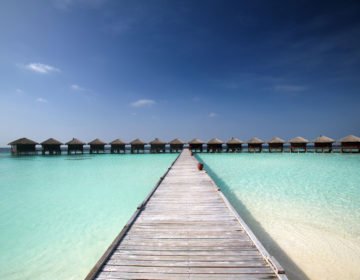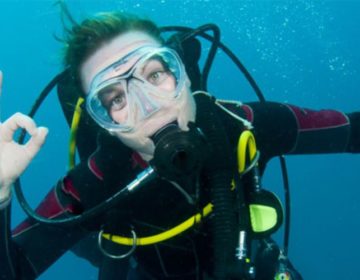Mulaku Atoll has plenty of diving options to choose from with long channel drift dives on the outer reef, small thilas inside the atoll studded with caves and prolific marine life; an abundance of quality inner atoll reefs, many with steep walls and overhangs; outer reefs with an almost continuous source of attractions, including sharks, manta rays, and whale sharks; and a splendid wreck dive. Drift diving in Mulee Kandu is a highlight for divers, and this channel is within easy range of the atoll’s two resorts. Medufushi Island Resort and Hakuraa Club. For divers making day excursions from the resort and for those on safari boats, there are 15 channels to choose from over a distance of 48 kilometers on the western side of the atoll. Some of these channels are relatively shallow and have a few thilas across the entrance. There are only four uninhabited islands on this side of the atoll, and they help to distinguish the nearby channels. In the north, there are three channels in a row with very long reefs into the atoll that are excellent locations for drift dives. All have outer reefs with steep drop-offs and interesting corners.

Mulaku Kandu
Mulaku Kandu is about 40 minutes south of Vattaru and is a rewarding dive location accessible only to safari boats or resort excursion boats. Generally, the visibility is very good with both incoming and outgoing currents. The narrow entrance to the channel is at a depth of 25 meters and divers can cross the entrance when conditions are favorable. A blanket of pure white sand glistens on the bottom from reflected sunlight. Stingrays are often here and on both corners are large coral outcrops, which make good starting and finishing points. These rocks are full of holes coated in pastel colored soft coral that conceal saber squirrelfish.
Currents can be powerful in Mulaku Kandu, and giant trevally, large tuna, white-tip, and grey reef sharks tend to gather around the channel entrance at these times. There are great barracuda and the smaller schooling barracuda and, in the early morning, hammerhead sharks.
The outer reef edge falls abruptly from 35 meters to over 100 meters and on the outside reef edge at 35 meters, large sea fans thrive in the good conditions. A drift dive inside the channel is a good way to finish the dive, as there are some overhangs with superb hard corals that fade away to sand and rubble at 20 meters. Many turtles are seen on the reef edge along with an abundance of reef fish.
 These rocks are full of holes coated in pastel colored soft coral that conceal saber squirrelfish (above).
These rocks are full of holes coated in pastel colored soft coral that conceal saber squirrelfish (above).
Diving Hints
If current permits, divers will find it worthwhile spending time around the entrance where the combination of clear water, white sand, and striking colors create the perfect atmosphere for an exhilarating dive and the right conditions for stunning photos.
Medhu Faru Makdu
This is the second channel in the north of the atoll with a depth around 22 to 25 meters. It’s a narrow channel, so if the current is not too strong, divers can cross from one side to the other. There are caves and overhangs below the edge at 30 meters. Large schools of fish are present on both corners, including barracuda, jacks, and fusiliers, as well as eagle rays and sharks.
Vanhuravalhi Kandu
This is the third channel and is the deepest of the three northern channels. Drift diving along the north side is a favorite dive beginning at a huge overhang between 12 and 40 meters. Deep inside are sea fans and many features, so it is a good idea to bring a torch here. On the corner are overhangs and large coral rocks where schooling fish tend to congregate. A short excursion into the channel and back will create opportunities to see sharks, eagle rays and trevally. The channel has a steep wall to 30 meters with overhangs and corals and drifting along the 1.5-meter channel is an ideal way to finish the dive. The other side of the channel has many of the same features and is an equally interesting dive.
 A short excursion into the channel and back will create opportunities to see sharks, eagle rays and trevally (above).
A short excursion into the channel and back will create opportunities to see sharks, eagle rays and trevally (above).
Veyvah Beyru
This dive is on Veyvah outside reef near the northern entrance to Mulah Kandu. The channel entrance is marked by a two-mile light near the corner. A ‘tsunami tree’ further north on the outside reef is a good starting point for drift divers if the current is flowing strongly towards the south. This is an excellent dive that can produce many surprises. The reef top is around five to 10 meters, sloping very gently to 30 meters or more on the outside. Near the channel entrance is a sandy plateau at 25 meters where a school of white-tip reef sharks ranges throughout the year, resting mostly during the day and feeding by night.
Beyond the plateau is another sand terrace at 30 meters with more white-tip reef sharks. The two plateaus merge into a wall studded with small caves and drop-offs. A series of small sandy inlets characterize sections of this reef. There are also coral bombies between 15 and 20 meters that act as cleaning stations for mantas during the south-west monsoon season. The regular appearance of whale sharks is an additional attraction of this site.
 Coral bombies act as cleaning stations for mantas during the south-west monsoon season. Image courtesy of Coco Cares – WordPress.com
Coral bombies act as cleaning stations for mantas during the south-west monsoon season. Image courtesy of Coco Cares – WordPress.com
Diving Hints
The entrance to Mulah Kandu is at 14 meters, and this shallow depth extends a considerable distance out to sea and across Mulee Kandu. The outer reef at Veyvah Beyru has a wide reef shelf with a gentle slope that drops steeply well out to sea. Further north of the dive point is ‘tsunami tree’ where the drop-off is closer to the reef and more visible. It is a good place to start, but the current is strong and the dive master must consider the strength of the current when diving here. If the current is slight, it is best to locate the sand terrace first and start diving here.
Muli Kandu (Hakura Express)
This is a long drift dive along the channel wall of Muli Island. It includes the small island of Boahuraa and a finger of reef protruding for more than 200 meters into the ocean. The reef has a rounded top at 15 meters and the outer end of the finger slopes gently to over 30 meters. Near Boahuraa, the reef becomes shallower, and the channel edge becomes more distinct. There is a proliferation of fish life here including black and humpback snapper that swirl in huge schools along with tuna, jacks and trevallies, Napoleon, batfish, bannerfish, Moorish idol, and fusiliers.
There are honeycomb moray eel on the reef and turtles are commonly seen here. Turtles congregate in the waters off Muli during breeding times, usually around the full moon. They are known as ‘vela’ in Divehi, and they lay their eggs on the sand at the northern point of Muli. This part of the island is reserved as a turtle sanctuary. Muli Kandu is one of the best sites in the atoll to view manta rays. These are most frequently seen during the southwest monsoon season between May and December. On the finger of reef between 10 and 15 meters are numerous cleaning stations where mantas circle, allowing extended periods of viewing.
 There are honeycomb moray eels (above) on the reef and turtles are commonly seen here.
There are honeycomb moray eels (above) on the reef and turtles are commonly seen here.
Diving Hints
Mulee Kandu is the only channel for almost the entire eastern side of Mulaku Atoll. Consequently, currents can be powerful here and should be understood and respected before diving. A strong cross-current can be prevalent on the outer reef finger, and a rapid down-current occurs on the channel corner. During difficult times, a quiet dive alternative is found to the south of the channel at Muli Beyru.
Muli Beyru
This reef lies on the outside reef of Muli Island. This dive starts a couple of boat lengths north of a ‘tsunami tree’ lying high and dry on the outer reef. There are two big canyons, or blocks, at 22 meters where stingrays gather. Most importantly, there are manta rays, black snapper and large schools of sweetlips on the reef at eight to 10 meters.
 Large schools of oriental sweetlips on the reef at eight to 10 meters.
Large schools of oriental sweetlips on the reef at eight to 10 meters.
(Source: Dive Maldives: A guide to the Maldives Archipelago. Tim Godfrey. Atoll Editions)



